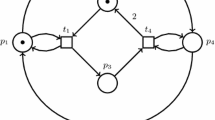Abstract
We develop the mathematical machinery for the construction of an algebraic-combinatorial model using Petri nets to construct an oriented matroid representation of biochemical pathways. For demonstration purposes, we use a model metabolic pathway example from the literature to derive a general biochemical reaction network model. The biomolecular networks define a connectivity matrix that identifies a linear representation of a Petri net. The sub-circuits that span a reaction network are subject to flux conservation laws. The conservation laws correspond to algebraic-combinatorial dual invariants, that are called S-(state) and T-(transition) invariants. Each invariant has an associated minimum support. We show that every minimum support of a Petri net invariant defines a unique signed sub-circuit representation. We prove that the family of signed sub-circuits has an implicit order that defines an oriented matroid. The oriented matroid is then used to identify the feasible sub-circuit pathways that span the biochemical network as the positive cycles in a hyper-digraph.
Similar content being viewed by others
References
Alberty, R. A. (1992). Conversion of chemical equations to biochemical equations. J. Chem. Ed. 69, 493.
Alberty, R. A. (1994). Review of biochemical thermodynamics. Biochim. Biophys. Acta 1207, 1–11.
Alberty, R. A. (1996). Calculation of biochemical net reactions and pathways by using matrix operations. Biophys. J. 71, 507–515.
Alberty, R. A. (1991a). Chemical equations are actually matrix equations. J. Chem. Ed. 68, 984.
Alberty, R. A. (1991b). Equilibrium compositions of solutions of biochemical species and heats of biochemical reactions. Proc. Natl Acad. Sci. USA 88, 3268–3271.
Arkin, A., J. Ross and H. H. McAdams (1998). Stochastic kinetic analysis of developmental pathway bifurcation in phage λ-infected Escherichia coli cells. Genetics 149, 1633–1648.
Bailey, C. G. and J. S. Oliveira (1998). An axiomatization for cubic algebras, in Mathematical Essays in Honor of Gian-Carlo Rota, B. E. Sagan and R. P. Stanley (Eds), Birkhaüser.
Bailey, C. G. and J. S. Oliveira. Another Universal Axiomatization of Cubes (in preparation).
Bailey, C. G. and J. S. Oliveira (2001). MV-Algebras and Cubic Algebras, submitted to the Annals of Combinatorics.
Berge, C. (1973). Graphs and Hypergraphs, New York: American Elsevier Publishing Company.
Björner, A., M. Las Vergnas, B. Sturmfels, N. White and G. Ziegler (1993). Oriented Matroids, CUP.
Clark, B. L. (1988). Stoichiometric network analysis. Cell Biophys. 12, 237–253.
Diestel, R. (2000). Graphs Theory, 2nd edn, New York: Springer.
Garey, M. R. and D. S. Johnson (1979). Computers and Intractability: A Guide to the Theory of NP-Completeness, Murray Hill, NJ/San Francisco, CA: Bell Labs./W. H. Freeman and Co.
Henriksen, C. M., L. H. Christensen, J. Nielsen and J. Villadsen (1996). Growth energetics and metabolic fluxes in continuous cultures of Penicillium chrysogenum. J. Biotechnol. 45, 149–164.
Karp, P. D. et al. (1998). EcoCyc: encyclopedia of Escherichia coli genes and metabolism. Nucleic Acids Res. 26, 43–45.
Kauffman, S. A. (1971a). Gene regulation networks: a theory for their global structure and behavior. Curr. Top. Dev. Biol. 6, 145.
Kauffman, S. A. (1993). The Origins of Order: Self-organization and Selection in Evolution, New York, NY: Oxford University Press.
Kohn, M. C. and W. J. Letzkus (1983). A graph-theoretical analysis of metabolic regulation. J. Theor. Biol. 100, 293–304.
Kohn, M. C. and D. R. Lemieux (1991). Identification of regulatory properties of metabolic networks by graph theory. J. Theor. Biol. 150, 3–25.
Mavrovouniotis, M. L. and G. Stephanopoulos (1990). Computer-aided synthesis of biochemical pathways. Biotechnol. Bioeng. 36, 1119–1132.
McAdams, H. H. and A. Arkin (1997). Stochastic mechanisms in gene expression. Proc. Natl. Acad. Sci. USA, Biochem. 94, 814–819.
Metropolis, N. and G-C. Rota (1978). Combinatorial structure of the faces of the n-cube. SIAM J. Appl. Math. 35, 689–694.
Oster, G. S., A. S. Perelson and A. Katchalsky (1973). Network thermodynamics: dynamic modelling of biophysical systems. Q Rev of Biophys 6, 1–134.
Papoutsakis, E. and C. Meyer (1985). Equations and calculations of product yields and preferred pathways for butanediol and mixed-acid fermentations. Biotechnol. Bioeng. 27, 50–66.
Peusner, L. (1986). Studies in Network Thermodynamics, Vol. 5, Studies in Modern Thermodynamics, Amsterdam: Elsevier.
Pons, A., C. Dussap, C. Pequignot and J. Gros (1996). Metabolic flux distribution in Corynebacterium melassecola ATCC 17965 for various carbon sources. Biotechnol. Bioeng. 51, 177–189.
Reddy, V. N., M. N. Liebman and M. L. Mavrovouniotis (1996). Qualitative analysis of biochemical reaction systems. Comput. Biol. Med. 26, 9–24.
Reisig, W. (1985). Petri Nets, An Introduction, W. Brauer, G. Rozenberg and A. Salomaa (Eds), New York, NY: Springer-Verlag.
Samoilov, M., A. Arkin and J. Ross (2001). On the deduction of chemical reaction pathways from measurements of time series of concentrations. Am. Inst. Phys. 11, 108–114.
Schilling, C. H. and B. O. Palsson (1998). The underlying pathway structure of biochemical networks. Proc. Natl. Acad. Sci., USA 95, 4193–4198.
Schilling, C. H. and B. O. Palsson (1999). Towards metabolic phenomics: analysis of genomic data using flux balances. Biotechnol. Prog., Am. Chem. Soc. and Am. Inst. Chem. Engr. 15, 288–295.
Schilling, C. H., S. Schuster, B. O. Palsson and R. Heinrichn (1999). Metabolic pathway analysis: basic concepts and scientific applications in the post-genomic era. Biotechnol. Prog., Am. Chem. Soc. and Am. Inst. Chem. Engr. 15, 296–303.
Schnakenberg, J. (1979). Simple chemical reaction systems with limit cycle behavior. J. Theor. Biol. 81, 389–400.
Seressiotis, A. and J. E. Bailey (1988). MPS: an artificially intelligent software system for the analysis and synthesis of metabolic pathways. Biotechnol. Bioeng. 31, 587–602.
Smith, W. R. and R. W. Missen (1982). Chemical Reaction Equilibrium Analysis: Theory and Algorithms, New York: Wiley.
Author information
Authors and Affiliations
Rights and permissions
About this article
Cite this article
Oliveira, J.S., Bailey, C.G., Jones-Oliveira, J.B. et al. An algebraic-combinatorial model for the identification and mapping of biochemical pathways. Bull. Math. Biol. 63, 1163–1196 (2001). https://doi.org/10.1006/bulm.2001.0263
Received:
Accepted:
Issue Date:
DOI: https://doi.org/10.1006/bulm.2001.0263




